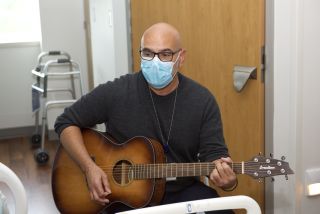Therapy
Music Belongs in the Hospital
A Personal Perspective: Music therapy can be effective for the healing process.
Posted June 10, 2024 Reviewed by Lybi Ma
The scene: A hospital room in an intensive care unit. The patient is in bed and on a mechanical ventilator (a machine that helps him breathe) with multiple IV lines connected to him, and various bags of fluids and medications hanging on a tree next to the bed. He is being fed through a tube inserted into his nose. There is a large monitor with readings of his heart rate, respiratory rate, oxygenation, and blood pressure; the beeping is soft but consistent and you feel at the base of your brain. A whiteboard on the wall lists medications and times and other charted numbers in bold back and vibrant red marker.
Also present is a technician, performing an echocardiogram, sitting at a mobile desk with a big monitor with various displays. The expression on his face says that this is a serious and important procedure. The patient’s wife is quietly sitting in the corner in an industrial-type chair, looking tired and just staring off. The room is somewhat dark, gloomy, and quiet with only the sounds of mechanical breathing, the beeping from the monitor, and muffled and eerie ultrasound tones coming from the echo machine. There is one other element introduced (seemingly out of place?). Me and my guitar.
From the first strum, the mood of the room slowly started transforming. As the music started progressing, it gradually overtook the dreary antiseptic feel of the surroundings. The tones of the machines were now (purposefully) within the melodic structure, the key, of the music. And the beeping heart rate rhythm acted as a metronome, syncing with the music’s tempo (again, purposefully). The initial light tension introduced in the music gradually modulated to more soothing and harmonic themes. The music changed everything.
The nurse, who frantically entered the room to check on meds, slowed when she saw me and gave me a soft smile as she gently touched my shoulder. She seemed comforted by my presence, by the music’s presence. You could see her shoulders drop as she let out a breath and subtly rolled her head from side to side before performing her tasks. The technician occasionally glanced over at me and smiled while manning his machine. His affect is much softer now. The patient’s wife sat back in her chair and closed her eyes. She let out a sigh as her face softened. It seemed that she was finally getting some much-needed rest.

And the patient? His heart rate slowly decreased, perhaps following the (purposeful) ritardando (gradual slowing) of the music. This is good. [The heart rate and or the respiratory rate will often sync or entrain with the tempo of the music. When the music's tempo is slowly decreased, the heart rate and or the respiratory rate will often follow, prompting a relaxation response. Even for patients on mechanical ventilation.] The entire mood of the room changed.
From the outside, it may have looked as if something in this scenario did not belong. Or, it may have looked nice to have someone performing music for the patient. However, on the inside, the music made a difference for all involved. On the inside, the music was presented with intention, clinically by a trained music therapist, and working towards achieving a goal—to help reduce anxiety. On the inside, music therapy was an integral part of the medical treatment plan.
More and more, music therapy (and all the creative arts therapies) is being recognized and utilized by medical teams as a means of helping their patients, particularly in dealing with anxiety and stress, as well as pain perception, and coping with hospitalization.
“Music therapy is the clinical and evidence-based use of music interventions to accomplish individualized goals within a therapeutic relationship by a credentialed professional who has completed an approved music therapy program.” (American Music Therapy Association).
One of the main benefits of music therapy is that it can help reduce the number of high-powered medications that can have multiple side effects, including prompting delirium, as a means of working with patients’ extraneous issues such as stress and anxiety, which can hinder the overall healing process. Music therapists generally use ‘live’ music, as the music can then be modified and manipulated, in the moment, to respond to the immediate needs of the patient.
On the inside, music (art, aesthetics) made a difference.
On the inside, music therapy made a difference.
Music is the one entity that can truly help change a surrounding, especially in a high-stress environment such as a critical care hospital setting. Music is an element that is simultaneously beneficial for patients, families, caregivers, and staff. Music is truly healing in a hospital setting. It makes a difference. And it belongs.
The healing power of music.
*The stories presented in this blog column are based on accounts and experiences.
References




